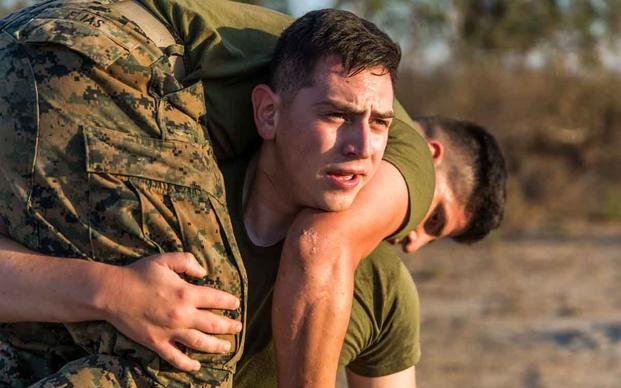Preparing for a military career involves much more than just passing a physical fitness test. While this initial physical assessment is a crucial entry-point event, it hardly scratches the surface of what is necessary for success as an active-duty member of the U.S. military, or even the reserves. To truly prepare for the physical requirements of the job, recruits must adopt a thorough view of fitness training that extends beyond mere calisthenics and cardio assessments, such as many initial fitness tests.
In the past 10-15 years, the military has recognized this limitation and pivoted toward a more functional fitness approach that reflects the actual demands of the profession, especially if you are “boots on the ground.” This transition can be seen in the development of new tactical fitness tests, which equip service members with the well-rounded abilities they will need.
Consider the creation of the Army Combat Fitness Test, the Marine Corps Combat Fitness Test, the Navy Human Performance Test and the Air Force Operator Fitness Test. These innovative assessments incorporate various fitness elements, specifically targeting components that transfer directly into military tasks. Strength, speed, power, agility, grip endurance, muscle stamina and load-bearing capacity are now integral segments of military fitness evaluations. Adding flexibility and mobility to the regular training programs each week will also benefit troops as they age into their 30s and 40s, making longevity possible within their military career and beyond retirement.
Here’s a closer look at five compelling reasons to embrace holistic fitness training for military members:
1. Real-World Application
Military life requires more than muscle stamina and cardio endurance. You need so much more for the varied demands of the job. Focusing on more functional fitness prepares recruits for advanced military training and military operations’ diverse physical and mental demands. Carrying heavy gear, maneuvering quickly in uneven terrain and completing complex physical tasks in high-stress environments are just a few job requirements. These require additional training in strength, speed, agility and durability beyond the basics of calisthenics and cardio events.
2. Enhanced Performance Across the Board
Military members and recruits improve their individual capabilities and overall group effectiveness by training across all fitness dimensions. As members of a well-working team, the physical talents spread across the group should be “good at everything.” However, each member may have more extraordinary abilities because of their previous athletic history, thus enhancing the effectiveness of the group overall. When a commander can rely on a basic standard of “well-rounded fitness” for everyone, plus the exemplary skills of individuals in the group, this can develop into better teamwork and operational success.
3. Injury Prevention
A well-rounded fitness training program emphasizes strength, stamina, mobility, stability and core development, which can significantly reduce the risk of injury during demanding physical activities. A military member well-versed in these areas is less likely to suffer from strains or overuse injuries. Preparation is key to avoiding common injuries brought on by inadequate and less diverse training programs.
4. Long-Term Health
A diverse fitness regimen encourages a lifestyle that promotes sustained health and fitness beyond military service. Service members training multiple fitness disciplines throughout the year (tactical periodization) can adopt these principles even after their military careers, leading to better overall wellness.
5. Adaptive Readiness
The nature of military operations is constantly evolving. A recruit trained in more well-rounded fitness routines is more adaptable and prepared to meet the diverse challenges in different terrains and combat situations and ensure greater operational readiness.
As the military shifts its focus toward a more functional and diversified approach to fitness assessment, recruits should embrace the opportunity to enhance their capabilities. Preparing for the multifaceted demands of military service means looking beyond the basic fitness test and committing to a comprehensive training regimen that prepares you for the realities of the field.
This isn’t just about getting in shape for a test. It’s about getting fit to be an asset in your profession and life beyond. Consider the following truths behind this fitness mindset adjustment:
- The harsh truth is that passing a fitness test is just the beginning of your military journey, not the peak of it.
- Relying solely on fitness test scores can leave you unprepared for the rigors of actual military job requirements.
- The path to military readiness demands more than just achieving a number on a fitness test; it requires a broader strategy.
- Well-rounded fitness is the cornerstone of practical military readiness.
- Embracing a more holistic approach to fitness could be the difference between success and failure at any level of military service.
In the military, it is common to find members who train only to take these tests. In the days before the turn of the century, these workouts were purely running and testing in calisthenics. While you need muscle stamina and cardio endurance, you need much more. Now, if you “train for the test,” the minimum requires lifting weights, running fast, carrying equipment and performing varied calisthenics and distance running events.
Are you prepared for the demands of military life? Take the next step in your training by visiting military.com/military-fitness. Break free from traditional workout constraints and embrace a functional fitness approach that strengthens your readiness.
Want to Learn More About Military Life?
Whether you’re thinking of joining the military, looking for fitness and basic training tips, or keeping up with military life and benefits, Military.com has you covered. Subscribe to Military.com to have military news, updates and resources delivered directly to your inbox.
Story Continues
Read the full article here

